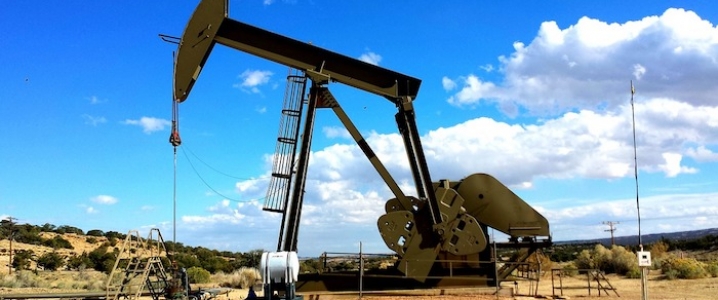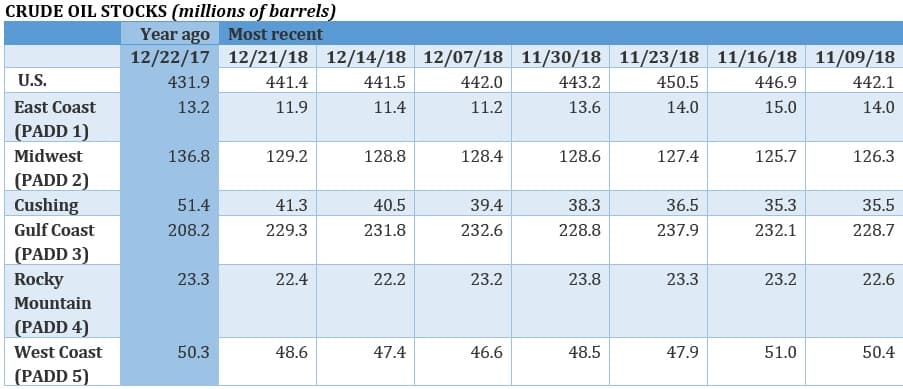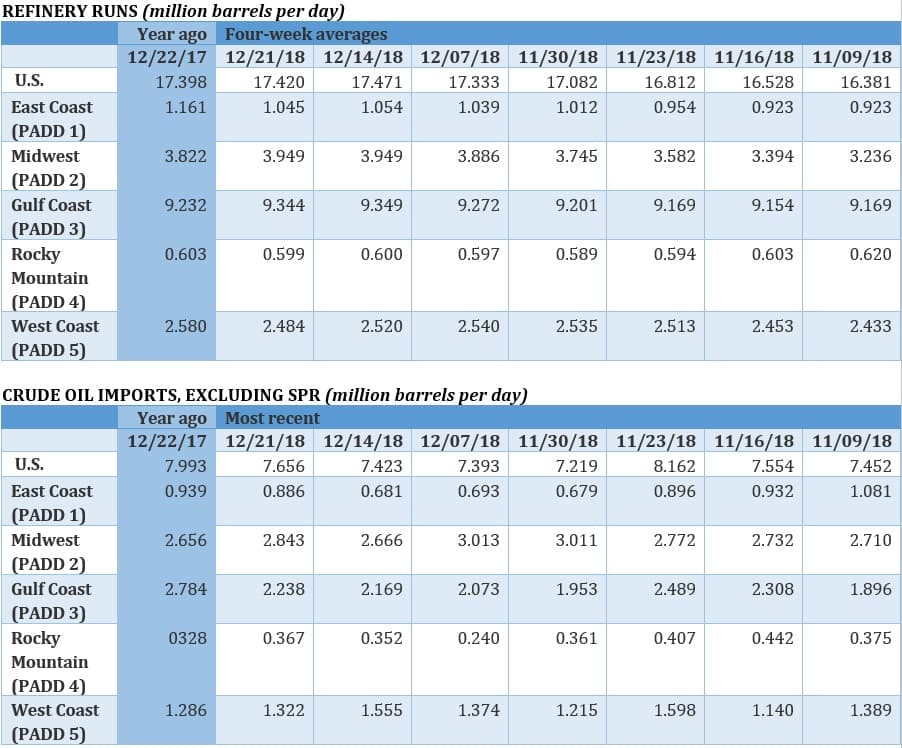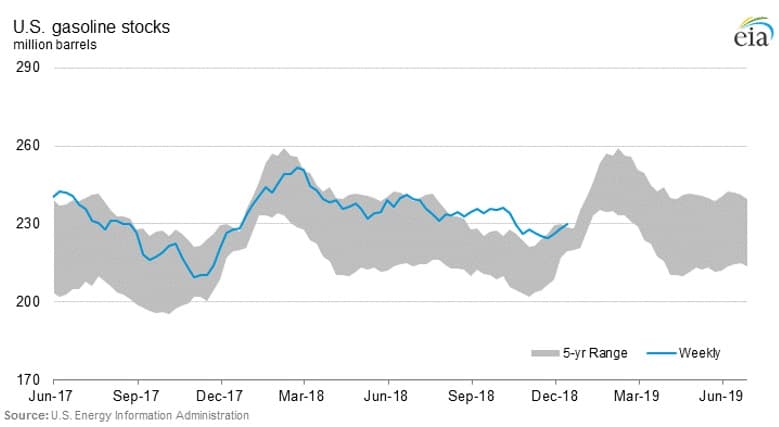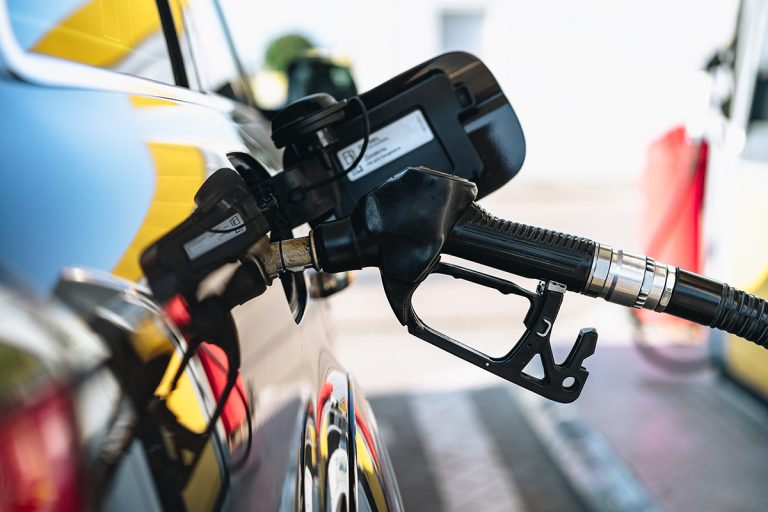Crude prices finished off the year with a small rally, and analysts are suggesting oil could climb even higher in the coming months.
(Click to enlarge)
(Click to enlarge)
(Click to enlarge)
(Click to enlarge)
(Click to enlarge)
(Click to enlarge)
(Click to enlarge)
(Click to enlarge)
Wall Street: Oil prices will rebound.Most major investment banks are forecasting a rebound in oil prices in 2019. Price forecasts vary widely, but most have both WTI and Brent above current spot prices. Bank of America Merrill Lync, for instance, sees WTI averaging $59 per barrel in 2019. Citi is at the bearish end with a $49 price target. For Brent, Barclays says the benchmark will average $72, and a half dozen other investment banks have price estimates within a few dollars of that price.
Financial volatility continues. After suffering steep losses at the start of the week, financial markets rallied strongly on Wednesday and into Thursday, regaining all the lost ground from Monday. Weak industrial data from China released this week still shows signs of a slowdown.
Saudi shakeup leaves MbS still in control. King Salman reshuffled the Saudi cabinet on Thursday, swapping out top security personnel. But the maneuvers did not remove power from crown prince Mohammed bin Salman. The officials that were elevated are close to MbS.
Formal OPEC+ structure looks doubtful. After suggesting multiple times earlier this year that OPEC and its non-OPEC partners – led by Russia – would formalize a permanent governance architecture to coordinate their efforts, the group is now downplaying such a development. Russia’s energy minister Alexander Novak said that the increase in red tape, plus antitrust risks from the U.S. government, make the idea too risky. “There is a consensus that there will be no such organisation. That’s because it requires additional bureaucratic brouhaha in relation to financing, cartel, with the U.S. side,” Novak told reporters. Instead, Novak said they will continue to cooperate without institutionalizing the arrangement. “This won’t be an organisation, this is some mechanism of cooperation: to convene, to discuss, adopt some memorandums, joint resolutions,” Novak.
Bank of England: Banks need to reduce climate risk. The head of the Bank of England, Mark Carney, says that banks need to do more to cleanse their balance sheets of climate risk. When asked by the FT if he is overstepping his institution’s remit, he dismissed that notion. “Absolutely not,” he said. “The issues around climate are wide ranging, and will touch virtually every sector.” He said banks are already modeling the financial risk from climate change and adjusting portfolios, though they need to do more. “They’re looking at specific climate-related risks in their portfolio, [such as] their exposure to certain bits of the auto sector,” he said. “Like it or not, this stuff is coming mainstream.”
Related: The Biggest Oilmen Of 2018
LNG shipments to Asia hit record. The volume of LNG shipments heading to Northeast Asia hit a record high in December, driven by demand from China and cold weather. LNG imports into the region – including China, South Korea, Japan and Taiwan – hit 20.5 million tonnes so far in December, or 5 percent higher than the previous monthly record.
Middle East oil producers hit by U.S. shale. As Bloomberg reports, U.S. shale is hitting major oil exporters from the Middle East on multiple fronts. For one, soaring production is lowering prices. But also, U.S. shipments of light crude to Asia are undercutting Saudi exports to the region. Moreover, U.S. exports of refined gasoline and naptha is creating a glut of those products in Asia, forcing prices lower.
Natural gas prices in Permian fell to zero, but rebounded. The glut of natural gas supply in the Permian basin – a byproduct of oil drilling – and the shortage of pipelines to take that gas to market, has led to a crash in prices. In November, natural gas prices traded near zero for much of the month, and even dipped into negative territory. Prices have since rebounded to $1.68/MMBtu in December. The inauguration of new oil pipelines next year could exacerbate the gas problem, as more takeaway capacity could lead to more drilling, which will lead to more gas production. “You’ll see things get worse and worse and worse as oil production grows and gas production grows alongside it,” J.R. Weston, an analyst for Raymond James & Associates Inc., told the Wall Street Journal.
Related: Mnuchin’s Bizarre Statement Rattles Markets
Shell plans on Vaca Muerta development. Royal Dutch Shell (NYSE: RDS.A) said that it plans to begin development of shale oil fields in Argentina after selling off refinery and retail fuel stations. Shell’s Vaca Muerta assets could produce 70,000 bpd by 2025.
Canadian production cuts set to take effect. Alberta’s mandatory 325,000-bpd cuts take effect in January. The decision to force companies to lower output has already provided a jolt to Canadian heavy oil prices. The province believes the full cuts only need to be in place for the first three months of the year. Thereafter, the province will try to unwind the cuts but do so in a way that corresponds with takeaway capacity.
EV sales in Norway reach 60 percent. Between September and November, 60 percent of all new vehicle sales in Norway were electric. EVs are rapidly gaining market share. In 2013, EVs had 3 percent of the market, but by 2017 that share reached 39 percent. For the full year of 2018, the figure looks set to be about 48 percent, even as EV sales accelerated in the final months of the year. Rystad Energy sees EVs capturing 90 percent of the market in Norway by 2022 and 100 percent by 2025.
—Oilprice

